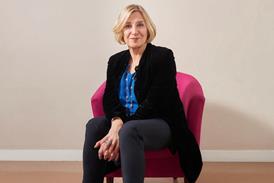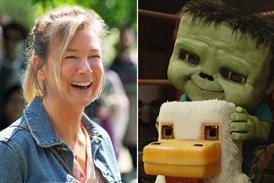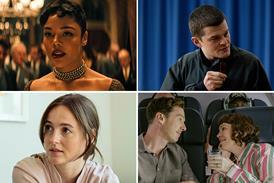For its sequel to arcade game-set hit Wreck-It Ralph, Walt Disney Animation opens up the story to the boundless reaches of the worldwide web. Ralph Breaks The Internet’s filmmakers speak to Screen.

After completing Disney hit Wreck-It Ralph six years ago, director Rich Moore and writer Phil Johnston thought they were done with loveable arcade-game lunk Ralph and his unlikely new best friend Vanellope.
The filmmakers felt the story of Ralph and Vanellope had been “wrapped up nicely”, says Moore. Besides, they reasoned, Walt Disney Animation Studios had not made a full-length theatrical sequel since 1999’s Fantasia 2000.
But teaming again on the studio’s 2017 Oscar winner Zootopia (aka Zootropolis) showed the duo, says Johnston, “that an audience is willing to take on ideas that are maybe more thoughtful and heady than the typical family entertainment, so long as it’s not preachy.”
Reconsidering the ending of Wreck-It, meanwhile, convinced Moore and Johnston there was something unresolved in Ralph and Vanellope’s friendship, something that could be explored in a new film with a fresh setting. So they pitched a sequel to Disney, “purely,” says Moore, “out of love of the characters and the worlds that we created.”
Back online
With Johnston this time serving as Moore’s directing partner as well as screenwriter, the team devised a story for Ralph Breaks The Internet that, after some adjustments suggested by Disney Animation’s famous ‘story trust’ of fellow filmmakers, takes the franchise into a whole new world. In the sequel, the well-intentioned Ralph, once again voiced by John C Reilly, is out to save the Sugar Rush car-racing game inhabited by Vanellope (Sarah Silverman) from closure. To find the necessary spare part to fix the vintage video game, Ralph and Vanellope use a router just installed in their arcade to go on a shopping expedition to the internet.
Moving from the arcade into the worldwide web gave the film the chance to introduce a slew of new characters. Wonder Woman star Gal Gadot voices Shank, the tough and skilful leader of a street-racing gang in Slaughter Race, an edgy online game that immediately grabs the attention of thrill-seeking Vanellope. British veteran Alfred Molina gives voice to Double Dan, the slimy proprietor of a dark-web operation that Ralph visits to buy a virus. And Empire’s Taraji P Henson brings to life website entrepreneur Yesss, head algorithm of the fictitious BuzzzTube site, where Ralph begins to learn about the perils of cyber-bullying.
The new characters, in turn, allowed the film to look closer at the relationship between its two returning protagonists, as Vanellope’s developing friendship with Shank leaves Ralph feeling neglected.
At the end of Wreck-It Ralph, says Moore, the title character has his longed-for best friend, “but he’s still defining himself by how that best friend sees him. That ending sentiment is in reality very unhealthy, it’s very co-dependent.” In the new film, chimes in Johnston, “that sentiment is the villain, the antagonist. There’s still insecurity there and Ralph allows that insecurity to become the force of antagonism in the film.”
Big-city action
Moving the action into the internet also called for a visual approach that could make the web feel like a vast but real location. “We wanted to be true to the first movie, aesthetically,” Moore explains. “In the first movie we built worlds inside the cabinets that housed video games in an arcade. So it was taking that idea further and expanding on it. We wanted to take Ralph and Vanellope to a big city to fix their small-town problem.”
To create the feel of a bustling metropolis, the production’s artists created buildings to represent websites and an elaborate transportation system to carry internet workers and users around. The feel was accentuated by populating the story with 434 unique characters — compared to just 187 in the first film — and casting 96 speaking roles. And the action was captured in a widescreen format with a 2.35:1 aspect ratio, creating an even more expansive feel.
The broader look was only possible because of recent advances in animation technology, Moore confirms. “This is not a movie we could have done six years ago when the first movie came out,” he says, “because we didn’t have the technology then to build an environment as big as this. It’s just within the last couple of years that our software has caught up to our imaginations.”
Specifically, the film made use of Disney Animation’s in-house rendering software Hyperion, first used to create the impressive cityscapes in 2014’s Big Hero 6 and then the realistic seascapes of 2016’s Moana.
“The key thing it’s changed is what we can do with our characters,” explains Ralph Breaks The Internet producer Clark Spencer of the Hyperion system. “This world is just so much more vibrant and tactile and real. There are shots with more than a million characters in the shot and you can do that because of the technology and how it’s evolved.”
Once it was created, the new setting allowed the directors to make playful references to a selection of the most familiar brands in cyberspace. While some of the sites visited by Ralph and Vanellope are invented, many — among them eBay, Amazon, Instagram and Snapchat — actually exist. Spencer reports that none of the real entities seen on screen paid for product placement, so Moore and Johnston were never constrained in their use of the familiar names.
A sequence set in the real-life Oh My Disney fan site allowed the filmmakers to play with characters from Disney’s Lucasfilm and Marvel labels (an animated version of late Marvel patriarch Stan Lee makes a fleeting appearance) and with a gathering of Disney Princesses (see below).
Johnston insists that he and Moore had a mostly free hand in making the jokey references to Disney properties. “We tend to get as close to the line as we can,” he says, “and if we don’t police ourselves, someone will tell us to step back.”
To be continued?
Self-referential humour should help Ralph Breaks The Internet — which opened in North America over the recent Thanksgiving holiday weekend — reach its audience as it rolls out into the global marketplace this winter. Whether it will help extend the Ralph franchise even further remains to be seen.
Spencer concedes there is “definitely an openness” to sequels now at Disney Animation, where Frozen 2 is currently in production for a November 2019 release.
Moore and Johnston, however, do not appear to have any serious plans for another instalment of the franchise they helped create six years ago. Coming up with a third chapter in the story of Ralph and Vanellope might be possible, says Johnston, “but we would really have to bang our heads for a long time to figure it out”.
























No comments yet